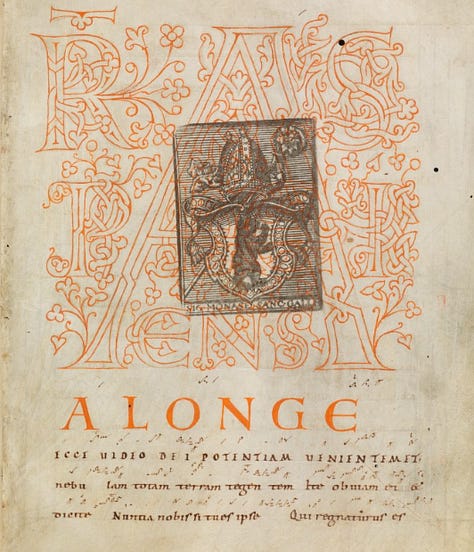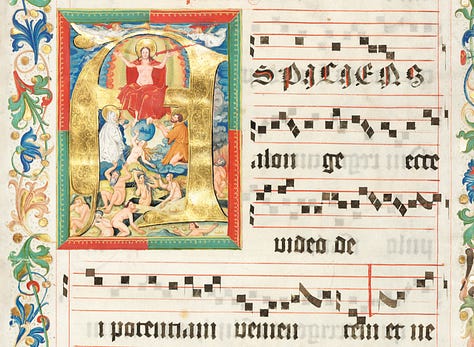Five Advent Chants Every Catholic Should Sing [+Free PDF]
Learn them this season!

Readers in the United States: Happy Thanksgiving!
The beautiful season of Advent is around the corner. One of the best things you can do during the season — both as a festive activity, and as a devotion — is to learn some of the beautiful chants proper to it. Today I’m going to share five of my favorite Advent chants, and in the spirit of my similar post from a few weeks ago, I will include a PDF of all the chants so you can easily print copies of them for singing at home or in church.
1. Rorate Coeli (Antiphon and Prose)
The devotional chant of this title most commonly encountered today is a Renaissance-era weaving of an ancient antiphon with scriptural verses. Often sung at the start of a “Rorate Mass,” as a communion hymn, or for other para-liturgical purposes, the chant is a poignant reflection on man’s need for salvation. It should be noted that the music for a sung Rorate Mass is different.
The ancient antiphon appears in various parts of the Divine Office and is taken from Isaiah 45:8: “Drop down, ye heavens, from above, and let the skies pour down righteousness.” All throughout Advent, this verse is used as a Messianic plea: only One is righteous, and he is the dew that drops from heaven upon the fleece of Gideon — always seen as a symbol of the virgin birth.
W. Rooke-Ley translates the antiphon thus, in a 1910 Book of Hymns, textually connecting it to the O Antiphons (which we’ll look at in a minute):
Mystic dew from heaven
Unto earth is given:
Break, O earth, a Saviour yield —
Fairest flower of the field.
Here’s a clear recording of it, providing music you can follow along with. A translation of the verses may be found here or here; an alternative recording may be found here.
As a bonus, I’ll also share Wiliam Byrd’s polyphonic setting of the text.
2. Conditor alme siderum (Hymn)
This is the hymn appointed for Vespers during Advent, and has been popularized in a translation of the Anglican J.M. Neale as “Creator of the stars of night.” Neal was a contemporary of St. John Henry Newman’s. The level of versifying in English was then at an all-time high, as the first two verses attest:
Creator of the stars of night,
thy people’s everlasting light,
Jesu, Redeemer, save us all,
and hear Thy servants when they call.
Thou, grieving that the ancient curse
should doom to death a universe,
hast found the medicine, full of grace,
to save and heal a ruined race.
(For the rest of the text, go here.)
This is a bit of a nasal recording, but the pace is good—these hymns need to be kept pretty brisk.
3. The O Antiphons (Antiphon)
The “O Antiphons” are a unique phenomenon in the musical calendar of the Church. A matching set of Vespers antiphons from December 17th to 23rd, they share the same melody, and each opens with a messianic title of Christ prefaced by “O” — “O Wisdom,” “O key of David,” etc. Here they are, in order of appearance.
17 December: O Sapientia (O Wisdom)
18 December: O Adonai (O Savior)
19 December: O Radix Jesse (O Root of Jesse)
20 December: O Clavis David (O Key of David)
21 December: O Oriens (O Dawn of the East)
22 December: O Rex Gentium (O King of the Nations)
23 December: O Emmanuel (O Emmanuel)
You will note that the first letter of the various titles is placed in bold. This is to draw attention to the reverse acrostic the letters form in Latin: ERO CRAS. This means “I will be [there] tomorrow.” Evidently the words of the Incarnate, the sentence is not complete until the 23rd, when they come true: Christmas is considered to have arrived at First Vespers on the 24th.
Many medieval authors delighted in acrostics such as this one, and ancient authors did as well. There is some speculation as to how old this series of antiphons is. Some claim they were already extant in such a form that Boethius’s phrase in the Consolation of Philosophy — “He is the highest good,” she [Lady Philosophy] said, “that rules all things mightily and delightfully arranges them” — is a citation of the antiphons rather than the passage from scripture (Wis. 8:1) on which they are based!
Each of the antiphons follows the same structure:
O [Primary Title], [elaboration of the title],
Come, and [elaboration of the verb].
For example:
O Emmanuel, our king and our lawgiver,
the hope of the nations and their Saviour:
Come and save us, O Lord our God.
Or:
O Wisdom, coming forth from the mouth of the Most High,
reaching from one end to the other,
mightily and sweetly ordering all things:
Come and teach us the way of prudence.
The antiphons also share the same melody, a distinctive mode 2 tune with a disputed note — should the highest note be a ti or a te (that is, a natural or a flattened note)?
Here it is with the sharp, from the director of the Floriani ensemble:
Personally, I think that the above recording takes it way too slow. Here it is with the more common flat — and at a much better tempo:
As far as noteworthy multi-voice settings of the O Antiphons, I have to highlight Arvo Pärt’s beautiful setting of the set. Some are murky, some militant, but always his word painting is brilliant. You can find all of them here. Pärt sets them in a German translation. My favorite is the sixth, with marching vocals that give “O King of the nations” a resounding power. The plea is beautiful, harkening back to Genesis: “Come and save the human race, which you fashioned from clay.”
4. Veni, Veni Emmanuel (Hymn)
This is certainly the best-known chant on this list: still widely sung in Latin, there are few church-goers indeed who would not have heard it at least in English, in the form of “O Come, O Come, Emmanuel” (another translation of J.M. Neale, which can be found complete here). A recording of the chant can be found here.
The melody, so full of longing and pleading, has given rise to dozens of polyphonic settings. One of them, with some very neat harmonies, is performed by the Gesualdo Six:
Something of a paraphrase of the ancient O Antiphons, the text of this hymn as it exists today surfaced in the 17th century. Strangely enough, the tune we all associate with this hymn was first paired to it only in 1851, when it was published in the Hymnal Noted by another Englishman, Thomas Helmore. He only vaguely referenced the tune’s source, and it would be over a hundred years — not until 1966 — that a 15th century manuscript containing the tune was discovered. Who neum?



5. Aspiciens a longe (Responsory)
For the final piece today, I’d like to up the musical game of our readers a bit. If you’ve been acing the previous chants, you might want to challenge yourself with this one. Definitely in the category of “very difficult,” this lengthy and beautiful responsory is a gem of allegorical text combined with haunting chant.
A responsory such as this belongs to the night office of Mattins (also spelled Matins). In the Roman Rite, Aspiciens a longe is sung as the first responsory on the first Sunday of Advent. Consider the cosmic introduction this provides:
Aspiciens a longe I look from afar: and lo, I see the pow’r of God coming, and a cloud cov’ring the whole earth. Go ye out to meet him and say: Tell us, art thou he that should come to rule over thy people Israel? High and low, rich and poor, one with another. Go ye out to meet him and say: Tell us, art thou he that should come to rule o’er thy people Israel? O come. Hear, O thou Shepherd of Israel, thou that leadest Joseph like a sheep. Tell us, art thou he that should come? Stir up thy strength, O Lord, and come. Come to reign o’er thy people Israel. Glory be to the Father, and to the Son, and lo, I see the pow’r of God coming, and to the Holy Ghost. and a cloud covering the whole earth. Go ye out to meet him and say: Tell us, art thou he that should come to reign o’er they people Israel?
Several variants of the music exist. Here’s one, sung by some French Benedictine nuns.
I find the incipit so haunting. Here’s a version that matches the notation in the PDF — I also like how this schola really keeps the chant moving, as well as pitching it pretty high.
Nothing gives chant a bad reputation like singing it in too low, going flat, and dragging the notes along. Alas, many scholas one hears do exactly that — leading people to comment, “I don’t like Gregorian chant, it’s so depressing and unjoyful.” Only bad chant is like that: excellent chanting is light, uplifting, and pleasurable to listen to. Listening to chant should convey “joy” and “peace” a hundred times stronger than it does impressions of “sorrow” or “penance.” Of course, the repertoire of chant itself varies in mood according to the seasons and feasts of the Church year, so there is a wide variety of emotion, including, in Holy Week, some heart-rending cries of anguish. But the chants for Advent, Christmas, Epiphany, Easter, and Pentecost are not like that.
The mainstream media and Hollywood do us no favors. For every self-flagellating monk, there must be a pounding Dies Irae in the background. But Gregorian chant — as with all medieval Catholicism — is not primarily a thing of dark cells, rough hairshirts, or fiery inquisitions; rather, chant and the Catholicism it adorned is a thing of light and love, of sunbeams falling through the windows of Chartres Cathedral, of St. Francis of Assisi joking about “Brother Ass,” of St. Martin cutting his cloak in half for the beggar.
Reminds me of the “Dark Ages, Modern Progress” meme, since much the same is true of Church music as it is of architecture:
With that thought, I’ll leave you to dispel the myth by chanting these beautiful songs of the . . . bright ages.
FINAL STEP: Download the PDF
All of these chants can be found in the free download below — crisp and easy to read, with the notation sourced from GregoBase. Happy chanting!
POSTSCRIPT: The Marian Antiphon for Advent is the Alma Redemptoris Mater. Head over to my previous article for commentary on it. You can find music for it in the accompanying PDF there as well (or, if you’re looking just for the Alma Redemptoris Mater by itself, go here).
Thanks for reading. Let us know in the comments if you find the PDF helpful.
In consideration of the work that went into this article and PDF preparation, please consider putting $5, $15, or $25 in my tip jar:
Thank you for your support of this and previous articles —
I enjoy writing for you!





Thanks so much for this wonderful Advent resource. I can’t wait to start singing with my family!
Simply splendid choices. Aspiciens a longe also has a lovely setting by Palestrina which my parish is singing on the Eve of Advent I this week.